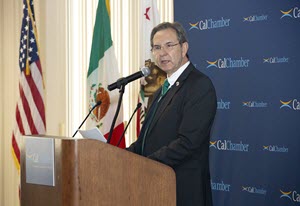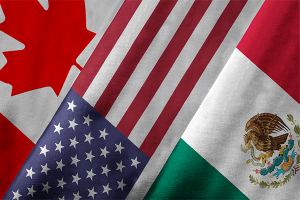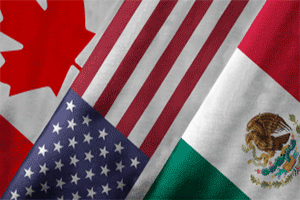North America Free Trade Agreement (NAFTA)

U.S.-Canada Reach NAFTA Agreement Before Deadline, Branding New Pact the U.S.-Mexico-Canada-Agreement U.S.-Mexico-Canada Trade Talks Continue U.S., Mexico Reach Preliminary Trade Update Agreement USMCA Fact Sheets from the U.S. Trade Representative: Modernizing NAFTA to Be a 21st Century Trade Agreement Strengthening North American Trade in Agriculture Agriculture: Market Access and Dairy Outcomes of the USMC Agreement Rebalancing Trade to Support Manufacturing USMCA State Fact Sheet: California The California Chamber of Commerce looks forward to learning more details of this agreement, |
CalChamber Urges Congressional Action on NAFTA Agreement
(May 15, 2018) The California Chamber of Commerce is urging Congress to approve a renegotiated North American Free Trade Agreement (NAFTA) quickly in the face of multiple deadlines for adoption of a modernized and rebalanced pact.
U.S. House Speaker Ryan has said Congress must receive the renegotiated NAFTA by May 17 to meet requirements of Trade Promotion Authority guidelines and the U.S. congressional calendar. U.S. Commerce Secretary Wilbur Ross has indicated the NAFTA negotiations must be completed by the end of May to have a 2018 congressional vote, and the July 1 Mexico election date looms.
CalChamber, Nationwide Chamber Coalition Call on President to Modernize NAFTA
The CalChamber, Nationwide Chamber Coalition Call on President to Modernize NAFTA, October 12, 2017 – The California Chamber of Commerce and a coalition of more than 300 state and local chambers from across the United States sent a letter this week, October 12, 2017, to President Donald Trump, urging him to support efforts to modernize the North American Free Trade Agreement (NAFTA). CalChamber is encouraging California businesses to send a letter to President Trump urging him to support the modernization of the North American Free Trade Agreement.
On June 12, 2017 the California Chamber of Commerce submitted comments on “Negotiating Objectives Regarding Modernization of the North American Free Trade Agreement with Canada and Mexico” to the U.S. Trade Representative – with a copy to the California Congressional Delegation. The full text of the CalChamber’s submission can be found here.
North America Free Trade Agreement (NAFTA)
The CalChamber actively supported the creation of the North America Free Trade Agreement (NAFTA) among the United States, Canada and Mexico, comprising 489.5 million people with combined annual trade with the United States being around $1.139 trillion in 2017. In 2017, goods exports totaled over $525.460 billion while goods imports totaled nearly $614.020 billion. U.S. Department of Commerce; World Bank
- U.S. Chamber of Commerce: NAFTA Triumphant: Assessing Two Decades of Gains in Trade, Growth and Jobs – The Chamber has released an updated version (as of May 2017) of their 2012 report on the benefits of the North American Free Trade Agreement (NAFTA).
- Trade with Canada and Mexico supports nearly 14 million American jobs, and nearly 5 million of these jobs are supported by the increase in trade generated by NAFTA.
- The expansion of trade unleashed by NAFTA supports tens of thousands of jobs in each of the 50 states—and more than 100,000 jobs in each of 17 states.
- Since NAFTA entered into force in 1994, trade with Canada and Mexico has nearly quadrupled to $1.3 trillion, and the two countries buy more than one-third of U.S. merchandise exports.
- The United States ran a cumulative trade surplus in manufactured goods with Canada and Mexico of more than $79 billion over the past seven years (2008-2014). For services, the U.S. surplus was $41.8 billion in 2014 alone.
- NAFTA has been a boon to the competitiveness of U.S. manufacturers, which added more than 800,000 jobs in the four years after NAFTA entered into force. Canadians and Mexicans purchased $487 billion of U.S. manufactured goods in 2014, generating nearly $40,000 in export revenue for every American factory worker.
- NAFTA has been a bonanza for U.S. farmers and ranchers, helping U.S. agricultural exports to Canada and Mexico to increase by 350%.
- With new market access and clearer rules afforded by NAFTA, U.S. services exports to Canada and Mexico have tripled, rising from $27 billion in 1993 to $92 billion in 2014.
- Canada and Mexico are the top two export destinations for U.S. small and medium-size enterprises, more than 125,000 of which sold their goods and services in Canada and Mexico in 2014.
Fifth California-Mexico Advocacy Day: “Challenges and Opportunities 20 years from NAFTA”
Consulate General of Mexico in Sacramento, May 6, 2014
The historic agreement, after passing through both the U.S. House of Representatives and the U.S. Senate, was signed into law by President Bill Clinton on December 8, 1993, and took effect on January 1, 1994.
On December 17, 1992, the NAFTA was signed by President George H.W. Bush, Mexico President Carlos Salinas, and Canadian Prime Minister Brian Mulroney. The framework agreement proposed to eliminate restrictions on the flow of goods, services, and investment in North America.
The CalChamber’s support for NAFTA is based upon an assessment that it serves the employment, trading and environmental interests of California and the United States, as well as, Canada and Mexico, and is beneficial to the business community and society as a whole. Since 1993, trade between the three NAFTA countries has nearly quadrupled.
The U.S. Department of Commerce shows that Mexico continues to be California’s number one export market.
NAFTA benefits
CalChamber support for NAFTA is based upon an assessment that it serves the employment, trading and environmental interests of California and the United States, as well as Canada and Mexico, and is beneficial to the business community and society as a whole.
The objectives of NAFTA are to eliminate barriers to trade, promote conditions of fair competition, increase investment opportunities, provide adequate protection of intellectual property rights, establish effective procedures for implementing and applying the agreements and resolving disputes, and to further trilateral, regional and multilateral cooperation.
Mexico
Mexico continues to be California’s number one export market, purchasing 15.5 percent of all California exports. California exports to Mexico amounted to $26.7 billion in 2017, a slight increase from 2016. Computers and electronic products remained California’s largest exports, accounting for 22 percent of all California exports to Mexico. Exports of transportation equipment and machinery from California to Mexico grew to total over $5 billion; with chemicals continuing to be a strong export sector as well.
U.S.-Mexico High-Level Regulatory Cooperation Council and Work Plan 2/2012
President Felipe Calderón and President Barack Obama instructed the creation of a Mexico – US High Level Regulatory Cooperation Council (HLRCC) in order to facilitate regulatory compliance, reduce transaction costs, and promote trade and investment between the two countries.
The HLRCC released its Work Plan on February 28, 2012, which represents an additional step to implement its objectives and increase regulatory cooperation between Mexico and the United States.
The main objectives of the HLRCC are:
- Making regulations more compatible, increasing simplification, and reducing burdens without compromising public health, public safety, environmental protection, or national security;
- Increasing regulatory transparency to build national regulatory frameworks designed to achieve higher levels of competitiveness and to promote development;
- Simplifying regulatory requirements through public involvement;
- Improving and simplifying regulation by strengthening the analytic basis of regulations;
- Linking harmonization and regulatory simplification to improvements in border-crossing and custom procedures;
- Increasing technical cooperation
To review the full text of the work plan
Canada
The U.S. Department of Commerce shows that two-way trade between Canada and the United States totaled $582 billion in 2017- the largest bilateral trade and investment relationship in the world.
Canada remained California’s second largest export market, with California exports to Canada increasing to over$16.7 billion in 2017. Canada purchases over 10 percent of all California exports. Computers and electronic products remained California’s largest exports to Canada, accounting for over 33 percent of all California exports to Canada.
Two way trade with Canada supports approximately 1,166,100 jobs in California, with many of those resulting from export growth under NAFTA.
In 2011, President Barack Obama and Prime Minister Stephen Harper announced the creation of a United States-Canada Regulatory Cooperation Council (RCC) and Beyond the Border (BTB) initiatives. In recognition of our $1 trillion annual trade and investment relationship, the RCC and BTB will foster formal cooperation between the U.S. and Canada to promote economic growth, job creation, perimeter security and other benefits to our consumers and businesses through increased regulatory transparency and coordination.
 Former Mexico President Policy Adviser Foresees Close Race in This Year’s Election Former Mexico President Policy Adviser Foresees Close Race in This Year’s ElectionCalChamber, March 9, 2018 The campaign to be the next President of Mexico could be a close one, the director of the Center for U.S.-Mexican Studies at the University of California, San Diego told a California Chamber of Commerce breakfast audience last week.“So far, it seems that this is going to be a very competitive election,” Professor Rafael Fernández de Castro said at the March 2 international breakfast meeting sponsored by Blue Diamond Growers. See a Mexico 2018 Election Fact Sheet.  CalChamber, Ontario (Canada) Chamber Join to Support NAFTA CalChamber, Ontario (Canada) Chamber Join to Support NAFTACalChamber, March 9, 2018CalChamber Co-Hosts Canada Day Luncheon on NAFTA Changes and State Agriculture CalChamber, March 2, 2018
|
NAFTA Links
NAFTA – Myth vs. Facts
NAFTA Secretariat Website
International Trade Administration Information on NAFTA
Canada Trading Partner Portal
Mexico Trading Partner Portal
USTR Trade Agreements – informational website
Related News
NAFTA Works is a website maintained by the Mexican Ministry of the Economy. Please visit their website to sign up for monthly newsletters related to the effectiveness of NAFTA.
Cross-Border Trucking
The new program is reciprocal and mutually beneficial and was established between Mexico and the United States under a Memorandum of Understanding signed on July 6th, 2011. Issuance of operating authority to Transportes Olympic is a positive step taken by the United States to come into full compliance with its commitments on long haul cross-border trucking services under the North American Free Trade Agreement (NAFTA).
- United States to Expand Trade Opportunities with Mexico through Safe Cross-Border Trucking
Federal Motor Carrier Safety Administration, January 9, 2015 - Federal Register Notice: Acceptance of Applications for Mexican-Domiciled Long-Haul Operations
Federal Motor Carrier Safety Administration, January 9, 2015 - Mexico and the U.S. are Moving toward a More Efficient Border
NAFTA Works, October 17, 2014 - Camp, Brady Statements on Lifting of Mexico’s Retaliatory Tariffs
U.S. House Ways and Means Committee, October 21, 2011 - Alliance Applauds U.S.-Mexico Trucking Deal Alliance to Keep U.S. Jobs, July 6, 2011
- CalChamber Backs Pilot Program to Settle Cross-Border Trucking Dispute with Mexico
Alert, May 6, 2011 - Camp, Brady Statements on U.S.-Mexico Trucking Dispute
House Ways and Means Committee, March 3, 2011






